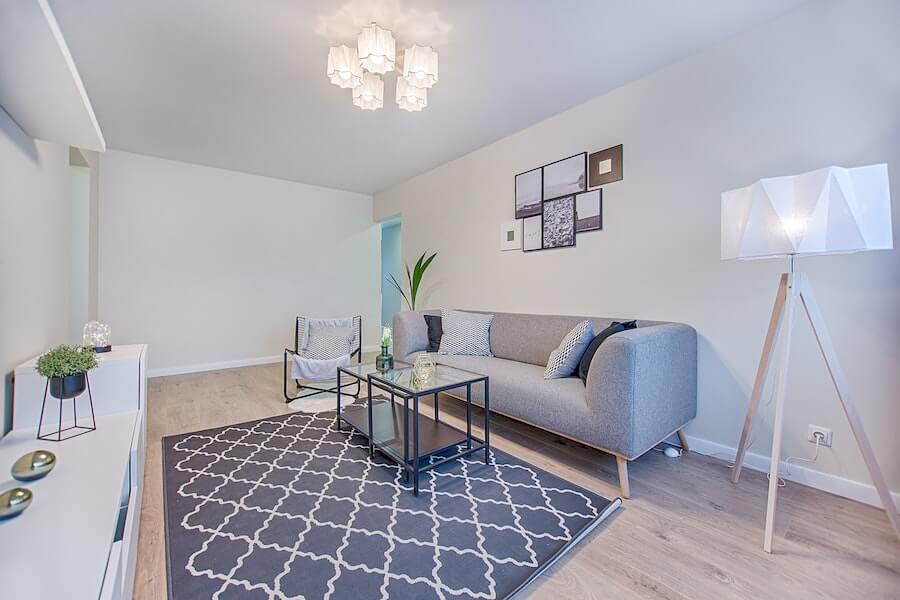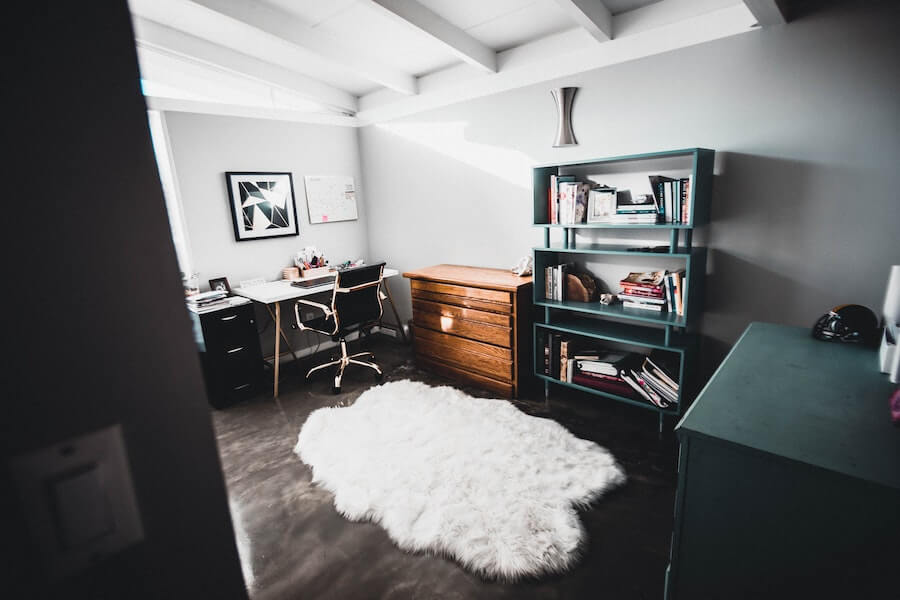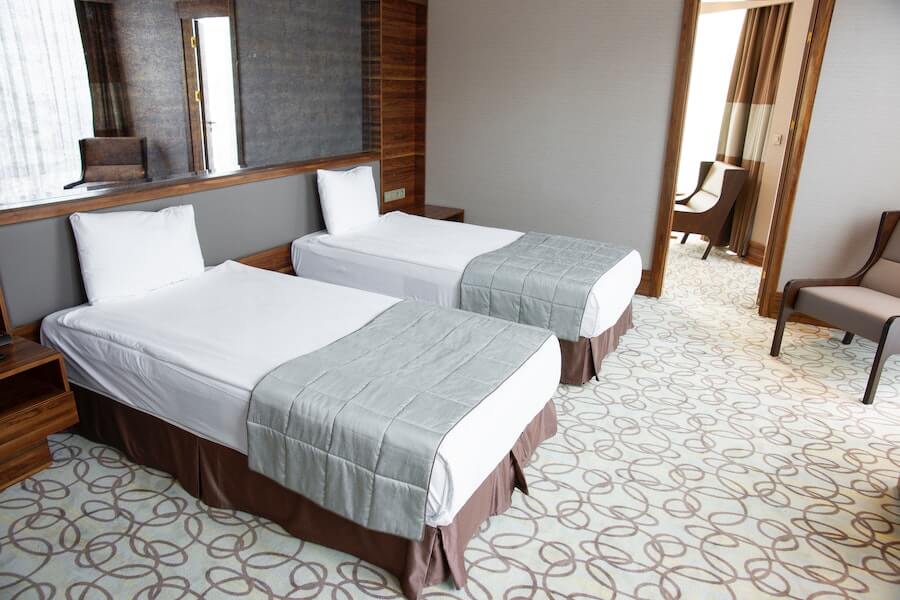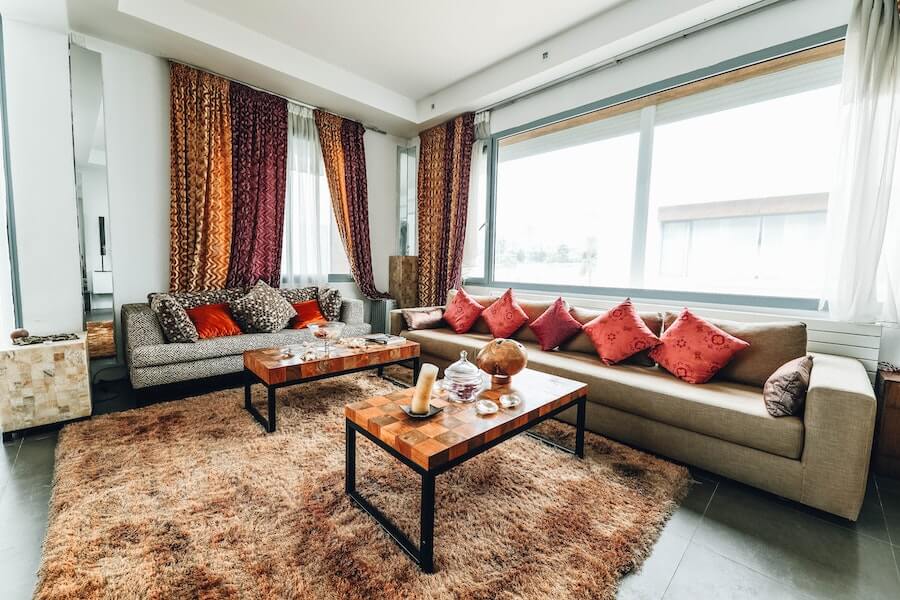
Many people around the world use rugs and carpets, and in different countries, their popularity and how people use them vary. For example, in the UK, many people prefer to carpet their homes to provide a comfortable surface underfoot when walking. However, in hot countries such as Spain or Saudi Arabia, people most commonly use rugs on top of tile floors. But, when it comes to rug vs carpet, which one is best?
Let’s examine which is the best choice for you, rug vs carpet, by understanding the benefits of each product and how efficient they are for your home.
Contents
What Is A Rug?

A rug is most commonly woven fabric that can come in various shapes, sizes and styles. People usually make rugs on a loom from cotton, jute, silk, wool or synthetic materials. They serve as a floor covering to protect the floor below, as a decorative item, and provide a softer barrier between the foot and a hard floor.
Rugs are moveable from one room to another, so you can roll them up in summer if you no longer need them or change their position as frequently as you like. A rug is usually much smaller than a carpet and can be anywhere from around half a metre up to four or five metres in length. But, of course, rugs can be as large as you need them to be, depending on the room size.
What Is A Carpet?

Carpets are floor coverings that fill up the entire space of a room, fastened at the edges or underneath. They are usually made from pile bonded to a coarse backing. However, carpets may also be made from wool, nylon, polyester or other synthetic materials.
They may have underlay below them to create a soft base when stepped on, and they can cover large spaces many metres across. Carpets can be cut to size and used in any home or business room, and they can even be attached to a staircase.
Once laid, carpets should not move around, and if you need a new carpet, you must remove the previous one entirely. Typically, people put down carpets in larger rooms measuring more than 3m x 3m, such as the living room and bedrooms. However, it is not uncommon for people to carpet their kitchens and bathrooms too.
Read More: Will Underfloor Heating Work With Carpet?
Rug vs Carpet: Which Is Best?
Deciding whether carpets or rugs are best for you is a decision you must make when choosing the flooring in your home.
Perhaps you want a lovely slate or hardwood floor with a rug to sit on top of it to prevent cold toes, or you might prefer an entirely thick carpeted room if you play on the floor with children or lie on the floor to read or watch television. Let’s look at the pros and cons of both rug vs carpet.
Rugs

Pros
- Easy To Clean
Rugs are easily cleaned and require lower levels of maintenance. If they are small, you can handwash them, give them a beating outside to get rid of the dust, or throw them in the washing machine.
- Moveable
You can easily move rugs from room to room as you decide, so you don’t have a permanent floor covering.
- Quick To Install
Rugs do not require lengthy installation. You simply place them down on the floor, and that’s all there is to it. But, of course, you can always add rug grips to stop it from sliding.
- Variety
Rugs are available in various styles, sizes, materials and colours, so you will always find that perfect rug to complement your home.
Cons
- Too Thin
Rugs do not provide much insulation to the home as they are usually only a couple of centimetres thick and only cover a small portion of the floor.
Carpets

Pros
- Fantastic Insulation
Carpets add a significant layer of insulation to the floor from wall to wall, so they are perfect if you are considering water underfloor heating as they will retain that heat for a long time.
- Safe Choice
Carpets prevent slips and trips because they do not have edges to catch as you pass over them, so they are better for young children and the elderly.
Cons
- Difficult To Install
Carpets are difficult to install as they remove all of the room’s furniture. However, once they are laid, they can last many years.
- Frequent Maintenance
Carpets require frequent hoovering to stay at their best, whereas when it comes to rug vs carpet, rugs can trap dust particles which can then be disposed of outside instead of with a hoover.
- Underlay
Carpets need underlay, which is an added expense. Plus, if the underlay is laid incorrectly, it can cause the carpet to warp. They also need runners around the edges which can damage the floor underneath.
Rug vs Carpet: Which Will You Choose?
Whether you choose carpets or rugs will depend on what kind of home you have and your flooring options. For example, a rug may complement a dining room to prevent the legs from scratching the floor underneath. However, a carpet might be the ideal solution for a bedroom to prevent slipping.
When it comes to rug vs carpet, what’s your preference? Let us know!
FAQs
What is the main difference between a rug and carpet?
The main difference is their size and installation. A carpet typically covers the entire floor of a room and is permanently installed, while a rug is smaller and can be easily moved from one place to another.
What are the advantages of choosing a carpet for my home?
Carpets provide wall-to-wall coverage, creating a uniform and cozy feel. They can help with insulation, noise reduction, and provide a soft and comfortable surface to walk on.
What are the advantages of choosing a rug for my home?
Rugs offer versatility and can be easily changed or moved to different areas of your home. They allow you to add color, texture, and patterns to a room, and they can define specific areas within a larger space.
Can a rug be used on top of a carpet?
Yes, rugs can be layered on top of carpets to add style and enhance the aesthetic of a room. This is a popular option for adding pops of color or creating visual interest.
Which option is easier to clean, a rug or a carpet?
Generally, rugs are easier to clean since they can be taken outside or sent to professional cleaners. Carpets may require professional deep cleaning or steam cleaning, which can be more time-consuming and costly.
Are there any considerations for people with allergies?
For individuals with allergies, rugs may be a better choice as they can be easily cleaned or replaced. Carpets can trap dust, allergens, and pet dander, requiring more frequent cleaning and maintenance.
Can rugs and carpets be used together in the same room?
Yes, rugs and carpets can be used together in the same room. For example, you can have a carpeted living room with a rug placed underneath the coffee table or in a seating area to add a decorative touch.
Which option is more cost-effective, rugs, or carpets?
Rugs tend to be more cost-effective since they are available in a wide range of prices and can be purchased in various sizes to fit your budget. Carpets, on the other hand, involve more extensive installation and may have higher upfront costs.
Sources
- Southern Living. (n.d.). Carpet vs. Rug: What’s the Difference? Retrieved from https://www.southernliving.com/home/carpet-vs-rug#:~:text=What%20we%20call%20carpet%20is,moved%20from%20place%20to%20place.
- Nazmiyal Antique Rugs. (n.d.). What is the Difference Between a Rug and a Carpet? Retrieved from https://nazmiyalantiquerugs.com/blog/what-is-the-difference-between-a-rug-and-a-carpet/
- The Rugs Cafe. (n.d.). Rugs vs. Carpets: What’s the Difference? Retrieved from https://therugscafe.com/blogs/news/rugs-vs-carpets
